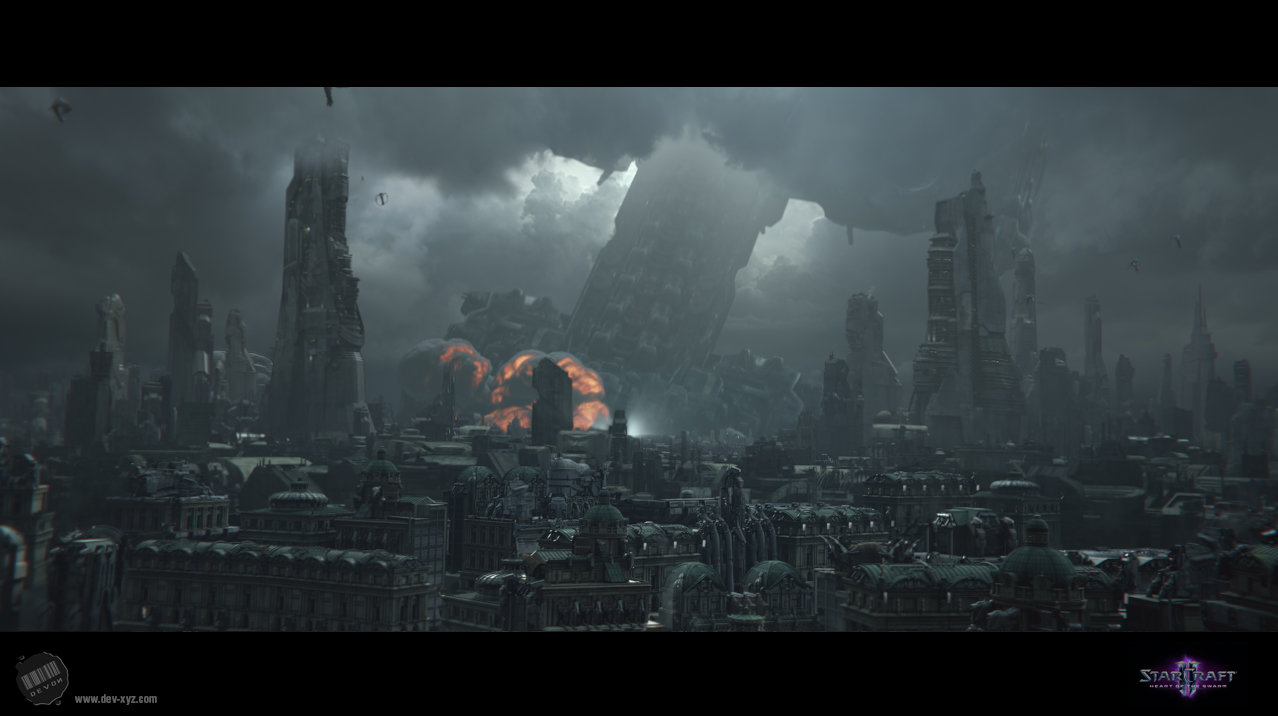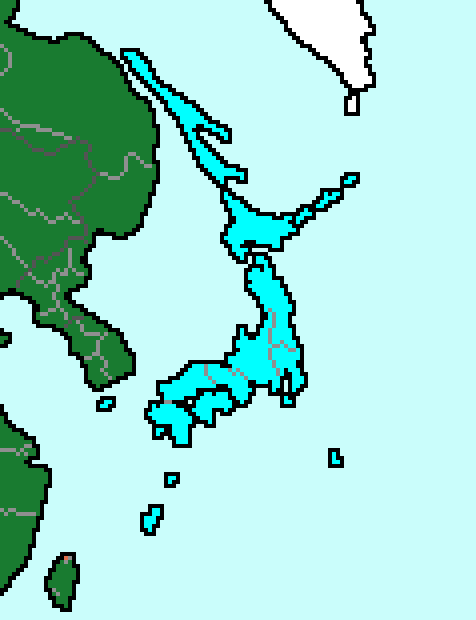High Concept: Technostalgic neo-Shogunate
Capital: Tokyo
Emperor: Takahiro
Shōgun: Katsuyoshi Satoshi
Historically resource-poor, Japan suffered greatly when the meteorite strikes upended the world order and destroyed global trade, leading to mass starvation as food imports evaporated and much of the technocratic infrastructure literally ran out of fuel. The Olympian revolt overwhelmed the Self-Defence Forces, exploiting increased computerization in its late-century military buildup to compromise and neutralize entire garrisons before a human response could be mustered. With much of the professional military effectively murdered in its sleep, the so-called "National Resistance Army" was hastily assembled from a mix of civilian volunteers, criminal desperados, and forced conscription. The mainland Olympian network was eventually destroyed, but at the cost of tens of millions dead and widespread desolation of the countryside. Japan's devastated population is still struggling to recover.
With the civilian government reduced to irrelevance, power shifted to history's traditional fall-back: empowered military strong-men. The tenuous unity of the National Resistance Army imploded as persistent disarray led to communications and supply breakdowns, and central control fractured. A neo-Sengoku ensued as the old JSDF commanders attempted to secure stability in their individual districts, while NRA hotheads became regional warlords, converting command hierarchy into personal fealty, raiding and pillaging rival commanders for desperately-needed food and supplies.
Within this maelstrom emerged one of the NRA's most asupicious officers of the "New Guard", Naoki Eguchi. An accountant before the Collapse, shrewd tactical acumen combined with personal bravery won him the rank of Lieutenant-Colonel by war's end. Stationed in Gifu Prefecture at the start of the civil war, Eguchi took command of his warband after his commanding officers were killed in a border raid, leading a reprisal campaign that decapitated the enemy leadership and secured his soldiers' allegiance. Realizing prolonged division would bleed the country dry, Eguchi opted not to settle and instead led his army in the "March to Tokyo", recruiting what warbands he could and slaughtering the warlords that resisted. Upon arrival he pledged his allegiance to the national government and was granted an audience with the Emperor, where he petitioned for Imperial sanction that he could use to bring the other warlords in line.
Initial campaigns were conducted in concert with other Tokyo-aligned factions. Eguchi frequently leveraged his wartime reputation with JSDF brass to reinforce his legitimacy, and his willingness to lead from the front boosted his image among the soldiers and earned the respect of rival commanders. After unification of central Honshu, he was named Supreme Commander
de jure by Imperial decree; by 2100 a combination of diplomatic manoeuvring and brute force had restored central authority over the mainland. Eguchi was initially reluctant to acknowledge his effective rule over Japan, but his popularity combined with his old accounting background convinced him to stay on as a stabilizing force and a somewhat-competent administrator in his own right, adopting the surname Katsuyoshi as a symbol of his prestigious position. Military logistics became the backbone to postwar recovery, with the armed forces pulling double-duty as local police.
What Katsuyoshi had assumed would be a ceremonial title solidified into a bona fide dynastic tradition by the end of his life. His descendant Satoshi, groomed for political office, is both a military commander and career statesman, ad-hoc martial law now resembling organized and tempered authority. While Japan has stabilized over the last century, it is still far from normalcy as chronic supply shortages stymie recovery and old battlefields are mined for salvageable materials. Even so, there is now true optimism that a renaissance is riding in on the next sunrise. Although essentially a figurehead office, the Imperial Family nonetheless acts as an anchor tethering the old Japan to the new.
Trouble: The Tool Wears Down
Despite the legacy of Olympus, Japanese society reached its zenith thanks to high technology, and in the wake of the Collapse technological innovation is the only thing preventing a complete regression to agrarian feudalism. However, whatever equipment survived the civil war in a usable state is a cherished luxury, as supply shortages starve a power grid shattered into pieces and crucial imports ended decades prior. Even as basic habitation, transport and communications services are afforded maximum priority in maintenance and upkeep, there are simply not enough spare parts to go around, and even the more prosperous cities routinely cannibalize what are sometimes priceless artifacts to keep the remainder in working condition.
Approaches
Covert: 1
Charm: 0
Force: 1
Science: 2
Thrift: 0
Stunt: Reduce, Reuse, Recycle
Decades of living in a demand-side economy have honed R&D's skill in maximizing the utility of even the slimmest advantage, while the general populace knows how to draw out limited supplies for as long as possible. Whenever a Science action related to economic technology Succeeds with Style, you may add +2 to the next roll about attempting to overcome a stability consequence. Stackable.
Aspects
Carry the Torch Forward
Electronics made modern Japan, and even in the midst of social collapse technological innovation (or at least, its sustenance) remains at the forefront of economic and scientific concerns. While the Collapse exposed the country's crippling addiction to high-tech gadgetry, the climate upheaval only underscores how critical it is to keeping the archipelago even borderline habitable, and salvageable equipment is treated with cult-like reverence. Until global trade becomes viable once more, the nation must rely on any and all means at its disposal, constantly looking for new uses of old techniques to mitigate its historical handicap.
Solid State Society
The scars of Olympus run deep, and a country that once wielded the razor's edge of robotic intelligence now casts a wary eye over so-called "thinking machines". In its place, human excellence has resurged, due in no small part to the precarious situation of the Japanese technological base. Nowhere is this exemplified more than the armed forces: enduring impossible odds, brutal weather, and their own comrades-turned-competitors, the survivors of the National Resistance Army were bloodied into some of the most tenacious fighters in the world. Mid-level computers still feature prominently in command-and-control and industrial automation, but advanced AI has been outlawed on grounds of national security. Technology may complement humanity, but never again may it supplement.
Brothers Broken in Arms
During the Collapse, gene-splicing contributed to an early-war foray into supersoldiers. While only a few rose to prominence within the NRA, during the civil war they were frequently derided as glory-hounds, often leveraging their augmentations to joust for leadership even when they lacked field experience—of the seventeen known Eloi warlords, twelve were wartime inductees, and eight of those were ill-reputed for thuggish leadership. This prompted a postwar backlash by Morlock vets who lambased "rich poseurs" "buying" their way past blue-collar conscripts that had earned their reputation (and their rank) with their own, unoptimized blood; meanwhile, "pre-war" Eloi were frequent draft-dodgers and avoided frontline combat, allegedly claiming they were more valuable in restoring the population. This was a common motivator in defections to Katsuyoshi's army, and most of those Eloi that supported him were demoted to mid-level commands after the civil war in order to prevent mutiny. The war's onset ended genemods as an organized industry, but the antipathy remains; while Eloi are undoubtedly an asset to the armed forces, promotion to general officership is throttled to prevent them consolidating as a faction within the top brass.


















